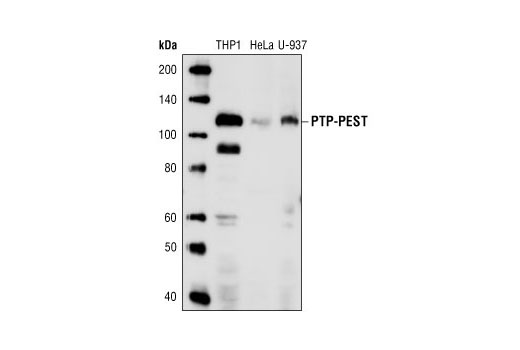WB, IP
H M R Mk
Endogenous
110 to 125
Mouse IgG1
#Q05209
5782
Product Information
Product Usage Information
| Application | Dilution |
|---|---|
| Western Blotting | 1:1000 |
| Immunoprecipitation | 1:50 |
Storage
Specificity / Sensitivity
Species Reactivity:
Human, Mouse, Rat, Monkey
Source / Purification
Monoclonal antibody is produced by immunizing animals with human PTP-PEST recombinant protein. The antibody recognizes an epitope within the amino-terminal 305 residues.
Background
PTP-PEST is a ubiquitously expressed cytosolic protein tyrosine phosphatase with multiple proline-rich regions that appear to be the docking sites for PTP-PEST binding partners or substrates (1). PTP-PEST regulates fibroblast adhesion, migration, and cytokinesis through its association with and dephosphorylation of p130 Cas, paxillin, PSTPIP1, WASP, and other adhesion molecules (1-5). By modulating phosphorylation states of Shc, Pyk2, Fak, and WASP, PTP-PEST negatively regulates lymphocyte activation (1,6). In mammary epithelial cells, EGF facilitates the dephosphorylation of Jak2 by PTP-PEST, thereby interfering with lactogenic hormone PRL signaling (7). PTP-PEST dephosphorylates c-Abl as well, which affects the phosphorylation states of PTP-PEST substrates such as paxillin, p130 Cas, Crk, and PSTPIP1 (8).
PTP-PEST regulates adhesion and motility of cultured epithelial cells through modulation of Rho GTPase activity (9), and is required for integrin-mediated endothelial cell adhesion and migration (10).
- Davidson, D. and Veillette, A. (2001) EMBO J 20, 3414-26.
- Garton, A.J. and Tonks, N.K. (1999) J Biol Chem 274, 3811-8.
- Shen, Y. et al. (2000) J Biol Chem 275, 1405-13.
- Angers-Loustau, A. et al. (1999) J Cell Biol 144, 1019-31.
- Côté, J.F. et al. (2002) J Biol Chem 277, 2973-86.
- Badour, K. et al. (2004) J Exp Med 199, 99-112.
- Horsch, K. et al. (2001) Mol Endocrinol 15, 2182-96.
- Cong, F. et al. (2000) Mol Cell 6, 1413-23.
- Espejo, R. et al. (2010) Am J Physiol Cell Physiol 299, C454-63.
- Souza, C.M. et al. (2012) J Biol Chem 287, 43180-90.
Species Reactivity
Species reactivity is determined by testing in at least one approved application (e.g., western blot).
Western Blot Buffer
IMPORTANT: For western blots, incubate membrane with diluted primary antibody in 5% w/v nonfat dry milk, 1X TBS, 0.1% Tween® 20 at 4°C with gentle shaking, overnight.
Applications Key
WB: Western Blotting IP: Immunoprecipitation
Cross-Reactivity Key
H: human M: mouse R: rat Hm: hamster Mk: monkey Vir: virus Mi: mink C: chicken Dm: D. melanogaster X: Xenopus Z: zebrafish B: bovine Dg: dog Pg: pig Sc: S. cerevisiae Ce: C. elegans Hr: horse GP: Guinea Pig Rab: rabbit All: all species expected
Trademarks and Patents
Limited Uses
Except as otherwise expressly agreed in a writing signed by a legally authorized representative of CST, the following terms apply to Products provided by CST, its affiliates or its distributors. Any Customer's terms and conditions that are in addition to, or different from, those contained herein, unless separately accepted in writing by a legally authorized representative of CST, are rejected and are of no force or effect.
Products are labeled with For Research Use Only or a similar labeling statement and have not been approved, cleared, or licensed by the FDA or other regulatory foreign or domestic entity, for any purpose. Customer shall not use any Product for any diagnostic or therapeutic purpose, or otherwise in any manner that conflicts with its labeling statement. Products sold or licensed by CST are provided for Customer as the end-user and solely for research and development uses. Any use of Product for diagnostic, prophylactic or therapeutic purposes, or any purchase of Product for resale (alone or as a component) or other commercial purpose, requires a separate license from CST. Customer shall (a) not sell, license, loan, donate or otherwise transfer or make available any Product to any third party, whether alone or in combination with other materials, or use the Products to manufacture any commercial products, (b) not copy, modify, reverse engineer, decompile, disassemble or otherwise attempt to discover the underlying structure or technology of the Products, or use the Products for the purpose of developing any products or services that would compete with CST products or services, (c) not alter or remove from the Products any trademarks, trade names, logos, patent or copyright notices or markings, (d) use the Products solely in accordance with CST Product Terms of Sale and any applicable documentation, and (e) comply with any license, terms of service or similar agreement with respect to any third party products or services used by Customer in connection with the Products.

